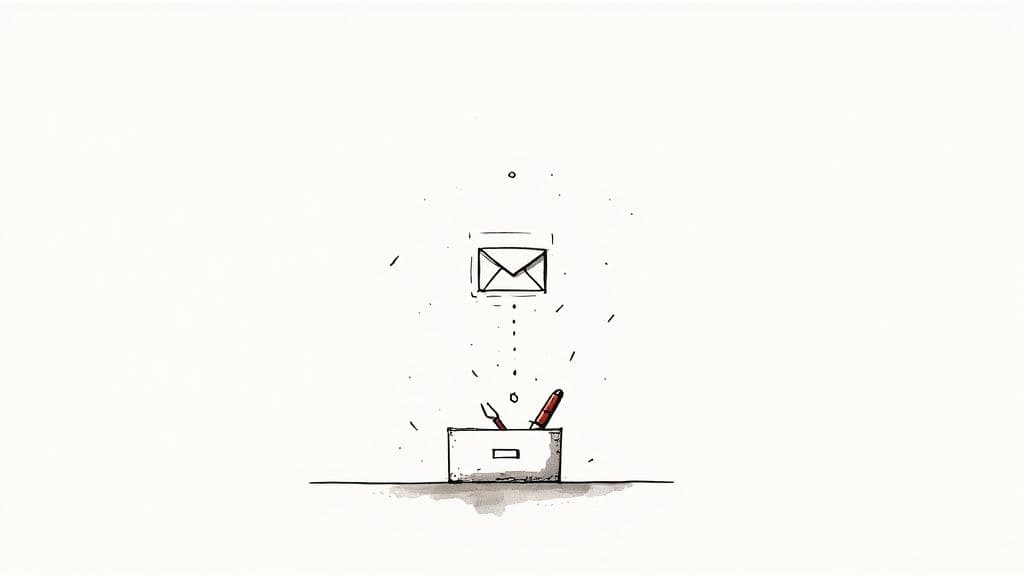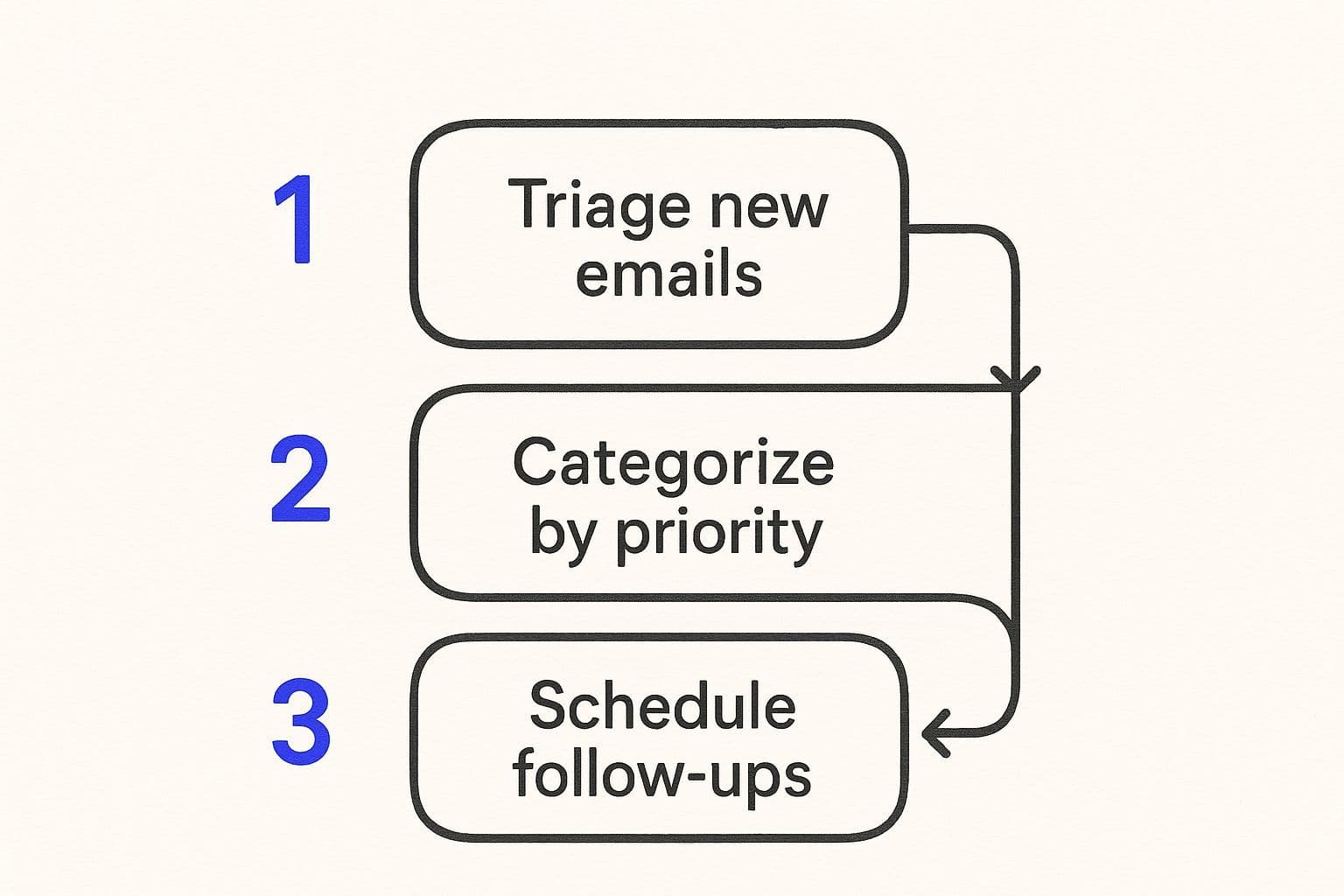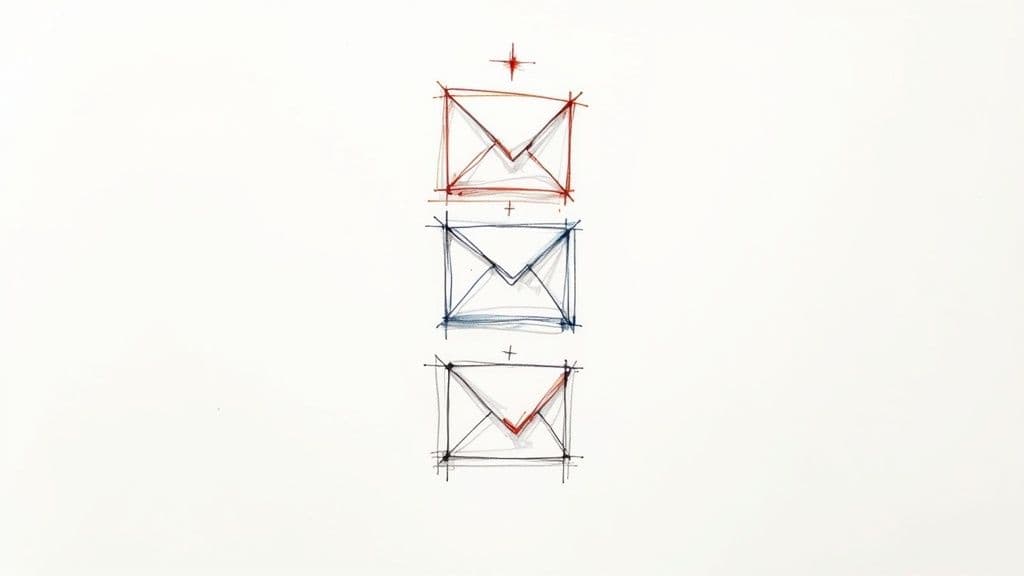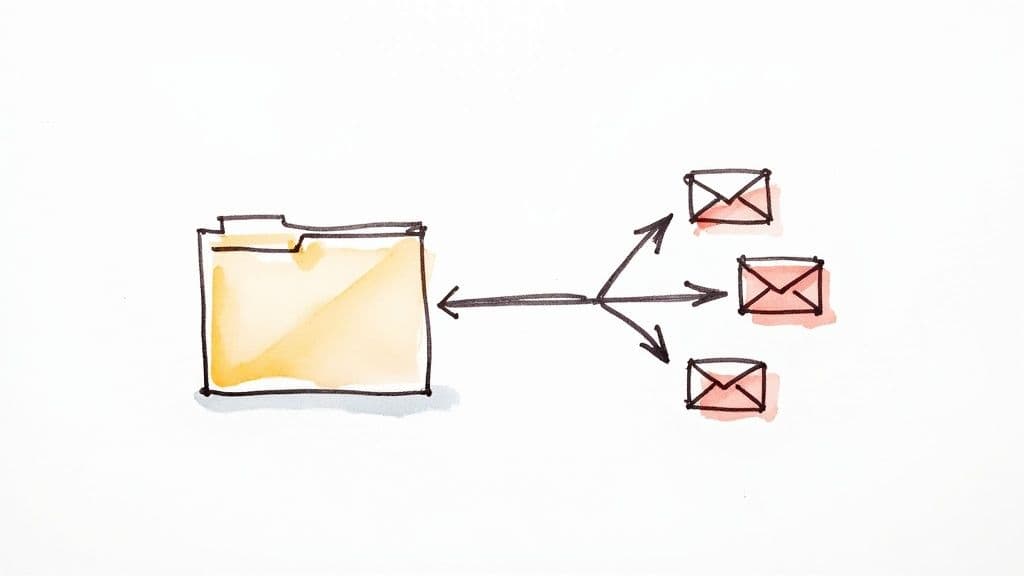Effective Email Inbox Management Strategies
Tired of email overload? This guide to email inbox management offers actionable tips and AI-powered tools to help you conquer your inbox and regain your focus.

Let's be honest, email inbox management isn't just about deleting spam. It's about building a system that turns a chaotic flood of messages into a clear, actionable workflow. It’s the process of organizing, prioritizing, and acting on emails so you can stay focused on what actually matters.
The True Cost Of A Cluttered Inbox

A messy inbox is more than just a digital eyesore. It’s a productivity black hole, quietly draining your focus and mental energy throughout the day. For any busy professional, that constant ping of new messages fragments your attention, making deep, concentrated work feel almost impossible.
Think about it: every unread email is an open loop. It's a task, a question, or a decision that sits in the back of your mind, creating a low-grade, persistent stress. You start worrying about missing a critical deadline from your boss, overlooking a client’s urgent question, or forgetting a key update from your kid's school. This constant state of alert wears you down, leaving you feeling reactive instead of proactive.
The Overwhelming Volume of Digital Communication
The sheer volume of communication we face makes a solid inbox strategy a non-negotiable skill. The average office worker gets hit with 121 emails a day, and with 86% of professionals citing email as their top choice for business communication, that flood isn't slowing down. This constant influx is precisely why we need better ways to stay afloat. You can discover more insights about these email statistics to see just how big the challenge is.
This digital deluge has very real consequences:
- Reduced Focus: Jumping between your actual work and your inbox creates "context switching," a productivity killer that can slash your effectiveness by up to 40%.
- Increased Stress: An overflowing inbox becomes a visual to-do list you can never conquer, feeding feelings of being overwhelmed and burnt out.
- Missed Opportunities: Truly important messages—from a potential client, a new lead, or your manager—can easily get buried under a pile of newsletters and low-priority CCs.
The real cost isn't just the time spent sorting emails, but the mental bandwidth lost to the constant background noise of a disorganized inbox. Reclaiming control means reclaiming your focus.
For commuters and parents juggling a dozen things at once, this challenge is even greater. Those brief moments of downtime—a train ride, waiting in the carpool line—are often the only chances to catch up. This is where tools that simplify the process become game-changers.
For instance, the Harmony AI app lets you manage your entire inbox with your voice. You can turn those hands-full moments into productive pockets of time, archiving, deleting, or flagging messages without ever needing to look at your screen. It's about building a sustainable system that actually works with your life, not against it.
Building Your Foundational Triage System
Let’s start with a simple but powerful mindset shift. Your inbox isn't a storage unit or a never-ending to-do list. Think of it as a processing station. The whole point is to get things out of it, not let them pile up and cause that familiar wave of Sunday-night dread.
To get there, I’ve always found the "Touch It Once" principle to be a game-changer. When you open an email, make an immediate decision about what happens to it. You have to break the habit of reading, closing, and then re-reading the same message five times without doing anything. That just drains your mental battery for no reason.
Every single email that lands in front of you should get one of four immediate jobs.
The Four-Action Triage Method
Your entire system can be built around just four core decisions. Making one of these choices for every email ensures nothing slips through the cracks and your inbox stays a place for active communication, not a digital junk drawer.
Here’s a quick-and-dirty guide to the four actions you can take with any email.
| Action | When To Use It | Example Scenario |
| Delete/Archive | The email is informational and needs no reply. | A shipping notification for a delivered package or a newsletter you've already skimmed. |
| Delegate | Someone else on your team is the right person for the job. | Forwarding a client query to the account manager and then archiving your copy. |
| Respond | You can give a complete reply in two minutes or less. | Quickly confirming a meeting time or answering a simple yes/no question. |
| Defer | It requires more thought, research, or a detailed response. | Moving a complex project update to an "Action" folder to tackle during your dedicated work time. |
This isn't just for office warriors. A project manager might defer a non-urgent project update to their "Follow Up" folder, while a parent can archive a school newsletter after adding key dates to their calendar. The system is flexible enough for any role.

This entire process hinges on consistency. Let's be real—with average email open rates hovering around 24%, most of what we receive is just noise. A solid filtering strategy helps you find the signal. That’s critical when response time expectations can range from 1.5 hours in finance to over 4 hours in education.
To really nail this, you need to bake email processing into your daily routine. This is where effective time management schedules come in, ensuring you have dedicated blocks for email instead of letting it interrupt your deep work.
And for all those times you aren't at your desk? You can keep the system running. While you’re driving or walking the dog, you can use voice commands with Harmony AI to keep the triage going. Just say, "Archive this email" or "Forward this to Sarah," and your inbox stays clean, no matter where you are.
Mastering Labels, Filters, and Automation

Manual sorting is a solid start, but the real magic in taming your inbox happens when you let the system do the heavy lifting for you. This is where you graduate from simply reacting to emails to proactively directing them. By setting up smart labels and filters, you build an automated workflow that sorts your mail before you even lay eyes on it.
Think of it like having a personal mailroom assistant. Instead of just dumping every letter on your desk, this assistant pre-sorts everything into designated trays. That's exactly what filters do. They work around the clock to keep your main inbox clean, reserving it only for messages that genuinely need your immediate attention.
Building Your Smart Labeling System
Before you can automate, you need a destination. Labels (or folders, if you're in Outlook) are those destinations. The first step is to think about the kinds of recurring emails that flood your inbox and group them into logical categories. The goal isn’t to create a complex library—it’s to build a system that mirrors your actual workflow.
Here are a few practical label categories I've found incredibly useful:
- Projects: Give each major project its own label (e.g., "Project Phoenix," "Q4 Marketing Campaign").
- Finance: A perfect catch-all for receipts, invoices, and bank statements.
- Newsletters: Batch all your subscriptions here. Now you can read them when you want to, not when they arrive.
- Team Updates: Funnel internal comms from specific departments or colleagues into one place.
- Family: Keep personal stuff, like school updates or weekend plans, separate from the work noise.
If you want to go deeper on creating a structure that sticks, our guide on how to use labels in Gmail has some more advanced tips. The key is to build a framework that feels intuitive to you.
Creating Filters That Actually Work For You
Once your labels are in place, you can create filters (or rules) to automatically route incoming emails. Most email clients let you build these rules based on different triggers, like the sender's address, words in the subject line, or even specific keywords in the body.
Let’s talk real-world scenarios. A busy parent could create a filter that automatically slaps the "School" label on any email coming from the school district's domain. They could even tell the filter to "skip the inbox," sending it directly to that folder. No more clutter, but important info is still organized and accessible.
An effective filter system isn't about hiding emails; it's about curating your focus. You're telling your inbox what deserves your immediate attention and what can wait.
A project manager could do something similar, setting up a filter for any email containing "Project Phoenix" in the subject. Boom. All relevant conversations are now automatically grouped together, saving them from having to manually hunt for updates later. You can create these for everything—recurring meeting invites, software notifications, industry news—turning a chaotic stream into a predictable, organized flow.
This level of organization is powerful, but what happens when you’re not at your desk? This is where Harmony AI closes the loop.
Imagine you're driving and a receipt hits your inbox. Instead of letting it sit there until you get back to a computer, you can just say, "Label this email 'Finance' and archive it." Harmony executes the command instantly, keeping your automated system humming along, even when your hands are full. It's the perfect way to make sure your well-structured inbox works for you anytime, anywhere.
Unlocking Hands-Free Productivity With Harmony AI
For anyone constantly on the move—commuters stuck in traffic, parents making breakfast, or professionals walking between meetings—traditional inbox management just doesn't work. Your hands are full, but the emails keep piling up. This is exactly where a tool like Harmony AI steps in, creating a whole new level of control by turning those moments of downtime into productive action.
Imagine you're driving to a client's office. Your phone buzzes with a new email. Instead of risking a dangerous glance or just letting it sit there, you can use a simple voice command. This isn't just about convenience; it’s about maintaining the very email triage and automation systems you've so carefully built, even when you're away from your keyboard.
It’s about reclaiming lost time. Watch how it works:
Voice Commands That Clear The Clutter
Harmony AI connects directly to your inbox, letting you handle all the essential management tasks with natural language. The real magic is its ability to understand context and execute tasks that would normally take several taps and swipes. This continuous, on-the-go management stops your inbox from becoming a source of stress before you even sit down at your desk.
Here are a few real-world scenarios where voice commands make a huge difference:
- During your commute: A promotional email from a retailer pops up. Instead of letting it clog your primary view, you just say, "Archive this email." It’s immediately filed away, keeping your main inbox clear for what actually matters.
- While making coffee: Your boss sends a message with an urgent request. You can say, "Star this email from John Smith," instantly flagging it so you won't forget it later.
- Walking the dog: You receive a meeting confirmation. A simple, "Reply ‘Confirmed, thank you’" handles the response without you breaking stride.
The goal of hands-free management is to process emails the moment they arrive. This prevents buildup and ensures your system works for you 24/7, not just when you're at your desk.
This approach flips your relationship with your inbox from reactive to proactive, no matter where you are. The key is to keep the momentum going. If you're looking for more ways to make your inbox work for you, check out our guide on how to automate email workflows for even more powerful strategies.
More Than Just Quick Replies
While quick actions are a huge win, Harmony AI also supports more complex email management. It helps you maintain the organizational structure you've already built with labels and filters, keeping everything tidy.
For instance, you receive an invoice while heading into the grocery store. You can just say, "Label this email as ‘Finance’ and move to archive." That single command executes a two-step process—categorizing and cleaning—in one fluid instruction.
This kind of voice-enabled workflow ensures that your automated system stays perfectly organized, even when you’re managing it on the go. It’s the final piece of the puzzle for a truly efficient and modern inbox strategy.
Maintaining A Secure And Focused Inbox

An organized inbox is great. A secure inbox is non-negotiable.
Proper email inbox management isn't just about sorting and labeling; it's about building a digital fortress against the constant barrage of threats and distractions. To protect your focus, you have to be deliberate about weeding out the junk that steals your attention and compromises your security.
This goes way beyond the old advice to not click on suspicious links. Today's threats are far more sophisticated, and the sheer volume can be overwhelming. In fact, spam now makes up roughly 48% of all incoming emails. That’s a staggering number, translating into billions of junk messages sent every single day.
They aren't just annoying—they’re often the tip of the spear for phishing scams and cyberattacks.
Proactive Defense Strategies
The best defense is a good offense. Instead of just reacting to spam when it lands in your inbox, you can take steps to cut it off at the source and harden your defenses. It’s all about practicing good email hygiene consistently.
A fantastic place to start is by aggressively curating your subscriptions. Hit that "unsubscribe" link at the bottom of any promotional email you no longer read.
What about those persistent senders who ignore your unsubscribe requests? Just about every email client has a "Block" feature. Use it. This sends all future messages from that address straight to the spam folder, so you never have to see them again.
Your inbox should be a tool for productivity, not a minefield of potential threats and distractions. Actively curating who can contact you is a critical step in reclaiming your focus.
The Rise of AI in Inbox Security
Trying to fight this battle manually is exhausting, which is precisely why AI-powered tools are becoming so essential. These systems work behind the scenes, identifying and neutralizing threats before they even have a chance to distract you. They analyze patterns, sender reputations, and message content to spot sophisticated phishing attempts that might otherwise fool a busy professional.
For a deeper dive into protecting your account, our guide on email security best practices covers more advanced techniques you can implement today: https://www.useharmony.com/blog/email-security-best-practices
This is another area where a tool like Harmony AI really shines. Beyond its voice commands for organization, its built-in intelligence helps you deal with unwanted mail on the fly. While you're driving, you can simply say, "Block this sender," and Harmony ensures you never hear from them again. It folds security right into your daily workflow, making it effortless to maintain a clean, safe inbox.
For broader strategies that go beyond email, you can learn how to stay focused at work and boost your productivity. Ultimately, a secure and focused inbox is the product of combining smart habits with powerful tools.
Even with the best system in place, old habits die hard. A few questions always pop up when people start to overhaul their inbox workflow. Let's tackle some of the most common ones.
How Often Should I Check My Email to Stay Productive?
This is a big one. The single biggest productivity drain is keeping your inbox open all day. It's like a dripping faucet, constantly demanding your attention.
Instead, try batching. Set aside three specific times a day to process your email—once when you start your day, once around midday, and once before you sign off. This simple change stops the constant context-switching and gives your brain the space it needs for real, focused work. If something is truly on fire, people know how to text or call.
Is the "Inbox Zero" Method Actually Realistic?
Ah, Inbox Zero. It’s a concept that gets a lot of hype, and the idea of a completely empty inbox every single day can feel a little... intense. For most of us, it probably is.
But don't dismiss the philosophy behind it. The real goal isn't necessarily hitting a literal zero. It's about treating your inbox as a temporary processing station, not a forever home for messages or a chaotic to-do list.
The point is to make a decision on every single email—delete, delegate, defer, or do it. Getting down to just a handful of pending items is a huge, sustainable win.
My Inbox Is a Complete Disaster. Where Do I Even Start?
If you're staring at thousands of old emails, the thought of organizing them all is enough to make you give up before you even begin. Don't do that. Instead, I have one piece of advice for you: declare "email bankruptcy."
Seriously. Just archive everything older than two weeks. It sounds radical, but it's incredibly freeing. If a message was that important, you can bet the sender will follow up. This move gives you a clean slate, allowing you to focus on managing new emails with your new system, which is a much more achievable goal.
How Can Harmony AI Help With Emails That Need a Detailed Response?
Harmony AI is a lifesaver for quick replies and archiving on the go, but it’s also a fantastic triage tool for those meatier emails you can't deal with while driving.
Picture this: you're in the car when a complex project update hits your inbox. You can't type out a thoughtful response, but you can't risk forgetting it either.
Just say, "Star this email and mark it unread."
Boom. That message is now flagged as a priority and bumped right back to the top of your list. When you finally sit down at your desk, it’s the first thing you see. You've just turned a few seconds of downtime into a head start on your most important work.
Ready to manage your inbox with the power of your voice? Join the thousands of professionals who use Harmony AI to stay organized and productive, no matter where they are. Start your free 14-day trial today and experience hands-free email management.
Harmony AI Planner
Plan your weeks, plan your life. Define your mission, plan weeks around your roles, and stay on track every day with AI guidance.
Personal Mission
Define your deeper why with a mission statement
Role-Based Planning
Plan weeks around work, family, and personal growth
AI-Powered Guidance
Get goal suggestions and daily nudges to stay on track
Engaging Experience
Celebrate progress with confetti and stay motivated